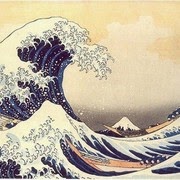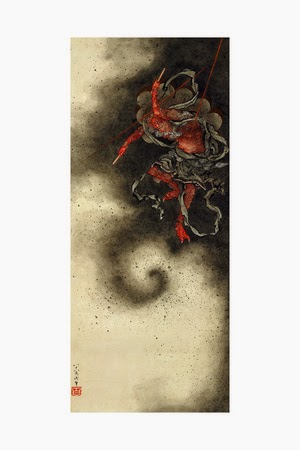MY HEAD IS STILL SPINNING........Hokusai, THE OLD MAN WHO WAS CRAZY ABOUT ART......
Hokusai, is perhaps not a name that we pronounce every day. Yet if you saw this engraving of « The Great Wave » which is one of the series « Thirty-Six Views of Mount Fuji » I can hear many voices saying « of course…… » At the exhibition yesterday a couple of women were in front of me looking at it and the conversation went something like this…..
« I didn’t realize it was so small » (25,9x37,2)
« But we all know it…… » (pause)
« My goodness, I never knew there were boats - are they fisherman? Shipwrecked? »
I always describe this engraving as the « Mona Lisa » of Japan. I’m sure many before me have described it as such. The mystery. The catastrophe, the size of the wave, it’s foam and no way could those fisherman survive.
The same day I went to see the film « Silent in Water » A Franco-spanish-japanese film where the inhabitants on a small island have an incredible respect for nature….the typhoon scenes are terrifying and Hokusai’s waves are very much there, crashing their foam onto the shore. The waves that have built up their energy, growing taller as they move in and break crashing onto the shore. That for me is « The Great Wave ».
Hokusai’s work is not unknown to me. The man himself has always been a fascination. He was born in 1760. Do you know many artists whose career was in six periods and adopting six names, or a name for himself by period? The periods will not remain in my memory banks nor will the names - but his remark - in 1834, will. He declared that he would need to live beyond the age of 110 to complete his life’s work. What devotion. He died in 1849 at the age of 89 after a life devoted entirely to his art. Apparently his last whispers to his daughter were that if he had lived just another five years, he would have become a true artist.
How many works were there on view? Over 350 reproductions and major works. Books, engravings, paintings….to the extent that part of the exhibition will be changed midway to show other works. There is no way this can digest all this, in one visit. However long I was there, I came out feeling drunk, my head spinning and asking myself what have I seen?
Any artist that has a minimalist approach works for me. Animals, humans, but perhaps not flowers however delicate they may be. I could look at his work when the detail was not such that your nose needed to be on the engraving to see what it was all about.
There was so much humor and yet it was drowned by painting upon painting closing in on the work I wanted to see.
Then there were the Manga. My daughter and granddaughter are connoisseurs, talking about the different characters for hours on end: trying to convince me that these cartoon characters are full of life (or full of violence):I have never been enthralled, but that’s me and my lack of interest in general of cartoon work. When I came into this gallery, I stopped. This period which dated from 1814-1878 was in actual fact Manga means « miscellaneous drawings ». And as his following grew larger, he began to produce manuals for other artists and craftsmen. Would you believe that there were 15 volumes produced containing more than 3,900 drawings of an astonishing variety? Perhaps not the Manga that this generation knows and that was proved by my granddaughter who gave the book I had bought a very cursory glance. I’m sure his work has an influence on Japan and th Manga today.
The exhibition opens - in France in the second half of the 19th century. It’s perhaps not surprising that so many of our artists of that period had a cultural shock looking at his work and how much Van Gogh and the impressionists were influenced by his methods and brush techniques.
It would have been easy to add pictures of artists who were influenced by his work. They were not shown in the exhibition.
I had given up buying catalogues. Beaux Arts had already sent a copy of the « hors-serie » which I had glanced at before I went. The little book that I bought I will treasure. A picture by page which can be studied. One at a time. All the beauty, the intricacy, the humor and the dedication to his work comes through. I don’t think that I will need to go back to see the new section.
 |
| The Great Wave (around 1830-1834) |
« I didn’t realize it was so small » (25,9x37,2)
« But we all know it…… » (pause)
« My goodness, I never knew there were boats - are they fisherman? Shipwrecked? »
I always describe this engraving as the « Mona Lisa » of Japan. I’m sure many before me have described it as such. The mystery. The catastrophe, the size of the wave, it’s foam and no way could those fisherman survive.
The same day I went to see the film « Silent in Water » A Franco-spanish-japanese film where the inhabitants on a small island have an incredible respect for nature….the typhoon scenes are terrifying and Hokusai’s waves are very much there, crashing their foam onto the shore. The waves that have built up their energy, growing taller as they move in and break crashing onto the shore. That for me is « The Great Wave ».
Hokusai’s work is not unknown to me. The man himself has always been a fascination. He was born in 1760. Do you know many artists whose career was in six periods and adopting six names, or a name for himself by period? The periods will not remain in my memory banks nor will the names - but his remark - in 1834, will. He declared that he would need to live beyond the age of 110 to complete his life’s work. What devotion. He died in 1849 at the age of 89 after a life devoted entirely to his art. Apparently his last whispers to his daughter were that if he had lived just another five years, he would have become a true artist.
How many works were there on view? Over 350 reproductions and major works. Books, engravings, paintings….to the extent that part of the exhibition will be changed midway to show other works. There is no way this can digest all this, in one visit. However long I was there, I came out feeling drunk, my head spinning and asking myself what have I seen?
Any artist that has a minimalist approach works for me. Animals, humans, but perhaps not flowers however delicate they may be. I could look at his work when the detail was not such that your nose needed to be on the engraving to see what it was all about.
 |
| water fall on the Kiso Rd. 1832 |
 |
| Head of an old man (date ?) |
 |
| The Red Fuji - 1834ish |
 |
| Travellers on a Bridge (date ? ) |
There was so much humor and yet it was drowned by painting upon painting closing in on the work I wanted to see.
 |
| Fisherman smoking beside a stream - 1835 |
 |
| Philosopher watching a pair of butterflies |
 |
| Mangas by HOKUSAI, Katsushika (1760 - 1849) |
 |
| A child playing with a hoop |
 |
| Pups in the snow |
 |
Flock of Chickens. Woodblock. 1830-1844. |
 |
| Women fishing |
 |
| Night chasing rats |
 |
| Dragon 1841 |
 |
| The Ghost of Kohada Koheiji - 1831-32 |
 |
| winter-evening-in-Japan |
 |
| Old-Tiger-in-the-Snow |
Then there were the Manga. My daughter and granddaughter are connoisseurs, talking about the different characters for hours on end: trying to convince me that these cartoon characters are full of life (or full of violence):I have never been enthralled, but that’s me and my lack of interest in general of cartoon work. When I came into this gallery, I stopped. This period which dated from 1814-1878 was in actual fact Manga means « miscellaneous drawings ». And as his following grew larger, he began to produce manuals for other artists and craftsmen. Would you believe that there were 15 volumes produced containing more than 3,900 drawings of an astonishing variety? Perhaps not the Manga that this generation knows and that was proved by my granddaughter who gave the book I had bought a very cursory glance. I’m sure his work has an influence on Japan and th Manga today.
 |
| Daily life gestures for Mangas |
 | |
|
 |
| Creatures for mangas |
 |
| Self-Portrait at the Age of-Eighty Three |
The exhibition opens - in France in the second half of the 19th century. It’s perhaps not surprising that so many of our artists of that period had a cultural shock looking at his work and how much Van Gogh and the impressionists were influenced by his methods and brush techniques.
 |
| Henri Rivière - 36 views of the Eiffel Tower 1888-1902 |
 |
| Henri Rivière - Autumn scene |
 |
| Eiffel Tower from Rooftops |
 |
| On the Scene |
It would have been easy to add pictures of artists who were influenced by his work. They were not shown in the exhibition.
I had given up buying catalogues. Beaux Arts had already sent a copy of the « hors-serie » which I had glanced at before I went. The little book that I bought I will treasure. A picture by page which can be studied. One at a time. All the beauty, the intricacy, the humor and the dedication to his work comes through. I don’t think that I will need to go back to see the new section.
 |
| Going up the stairs at the Grand Palais.....Majestic |



Commentaires